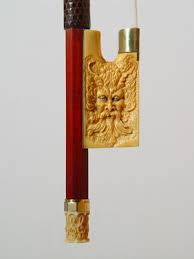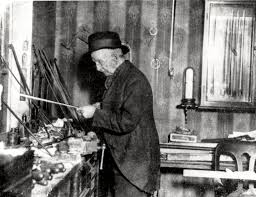Written by: Andy Fein, luthier at Fein Violins
 |
| Predecessor to Cramer and Tourte Bows |
The English have as old a love for stringed instruments as anyone else in Europe. English musicians have patronized and cultivated some of the finest violin and bow makers the world has seen. We previously looked at
Early English Violin Makers. But without bows, these fine stringed instruments would just be plucked!
 |
| c.1800 School of Dodd Ivory Mounted Cello Bow |
English bowmaking, like instrument making, underwent large changes in the 18th century. Concert halls were continuing to grow, and the instruments and bows needed to become more robust to fill the halls. Both Cramer and Viotti, virtuoso violinists, made efforts to work with bowmakers to encourage the development of the modern bow. The partnership between bowmaker and artist became a very important driver of improving instruments and bows. Until artists demanded more, bows were convex or even straight and lacked an adjustable frog. The sound produced was sweet but lacked power.
 |
Wilhelm Cramer
|
 |
Giovanni Battista Viotti
|
The invention of a concave bow can be attributed to the encouragement and promotion of Wilhelm Cramer (1745-1799) who arrived to London in 1772 from Mannheim and held sway as the finest violinist of his day until Viotti arrived on the scene. Cramer worked collaboratively with early English bowmaker John Dodd to create the concave bow. They determined that a bend in the stick opposite of the ordinary bow of the time (convex) strengthened the stick and produced a fuller sound. Consequently, it also improved the action of the bow and allowed a much wider range of techniques to be used on the bow; spiccato strokes became a larger part of the repertoire due to this advancement. When switching the bow from convex to concave it was important to maintain the proper distance between stick and hair, thus a larger battle-axe head, much like our modern bows, was developed.
 |
| Tourte Bow |
Around the same time, or slight after, Viotti, who actually used a 'Cramer' bow, was working with Tourte to create an even more powerful bow. Viotti, having overtaken Cramer as the premier virtuoso soloist, desired an even more agile bow that carried sound to the farthest reaches of larger and larger halls. Again a partnership between artist and bowmaker was forged. This time, however, they expanded what had been done before by the Cramer and Dodd partnership. Viotti and Tourte made an even deeper bend in the concave bow and slightly lengthened the bow. To this day, Dodd's bows, although respected, are considered too short for modern playing.
Before the time of Dodd and Tourte, bows were cut to shape and the cut included a curve, but no added tension was created. In both Dodd and Tourte's bows, it was found that bending the bow stick after it was carved added even greater playing and tone potential. To this day, modern bowmakers put a bend in the bow by heating the stick and bending it. That curve is called the 'camber'.
 |
| An early Dodd bow with an ivory frog |
Although the 'Cramer' bow remained fashionable in England for 20 years after the Tourte bows were created, they quickly lost favor on the mainland. This fact accounted for a 20 year period in English bowmaking where change lagged, while the mainland and Tourte bows advanced.
Other innovations, both long-lasting and fleeting, occurred in England during the 18th century. A fleeting innovation was that of the collapsible bow. At this time violin cases did not have a place to store bows, often they were kept in a separate bow quiver. Thomas Tubbs began to create bows that could be collapsed to fit in the violin case. Most of the collapsible bows separated under the winding where a nickel insert was added that the bow end could be slid into for playing and out of for storage. Another unsuccessful idea, from WilliwamTubbs, was to replace the head of the frog with a clasp mechanism that allowed for at-home rehairs. Much like the surgical grips that many instrumentalists use today, Tubbs also tried to create a club like winding that provided a substantial grip that ideally would provide more power to the bow. All three of these ideas proved to be passing fads.
 |
Tubbs Bow
|
One long-lasting trend started on the mainland, and later adopted by the English, was the switch from ivory frogs to ebony. Harvesting ebony was less destructive to the environment and provided the same stability as ivory. To this day, you can find old bows with ivory frogs, but be careful as they carry with them many restrictions to their use, sale, and travel. More information may be found at
Tarisio.
 |
Elaborately Decorated Ivory Frog
|
Bowmakers, until Tubbs in 1830, were making for shops and were selling in shops. Tubbs, in fact, worked as a bowmaker for W.E. Hill until he struck out on his own. He left with bitter feelings towards the Hills and sought to create his own market. Once out on his own, he had the habit of restamping any Hill bows that came into his shop with his own stamp, thus you can see quite a few bows with a double stamp. Shops were not making bows that were being sought out, they were merely stamping the bows with the shop's name and sent the bows out when an instrument was purchased. Tubbs discovered an untapped market and began selling bows and trying to match the bow to its artist and instrument. This was a novel idea, but one that caught on. As one who has searched for bows in the past, I can tell you that it is often more difficult to find a bow than it is to find and instrument.
 |
James Tubbs in his workshop
|
Ever trying to improve things, the English have continued to produce great bows. With the great makers and advances of the 18th century, the factory-line mode of making bows, and the education of the Hills, violin making in England has and will continue to be a great source for bows. Give them a try, you are sure to find something interesting!
More fun pictures, podcasts, and information can be found at:
Birmingham City University Conservatoire
Ashmolean Instruments
Birmingham Conservatoire
Relevant resources:
The Violin Family and its Makers in the British Isles-Brian W. Harvey
The British Violin-John Milnes




No comments:
Post a Comment